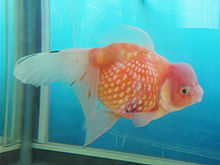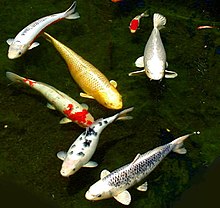Carp
| Carp | |
|---|---|

| |
| Common carp, Cyprinus carpio | |
| Scientific classification | |
| Kingdom: | |
| Phylum: | |
| Class: | |
| Subclass: | |
| Infraclass: | |
| Order: | |
| Family: | |
| Genera | |
|
Abramis | |
Carp are various species of oily[1] freshwater fish of the family Cyprinidae, a very large group of fish native to Europe and Asia. The cypriniformes (family cyprinidae) is traditionally grouped with the Characiformes, Siluriformes and Gymnotiformes to create the superorder Ostariophysi, since groups have certain common features such as being found predominantly in fresh water and the fact that they possess Weberian ossicles (an anatomical structure originally made up of small pieces of bone formed from four or five of the first vertebrae); the most anterior bony pair is in contact with the extension of the labyrinth and the posterior with the swimbladder. The function is poorly understood but it is presumed that this structure takes part in the transmission of vibrations from the swimbladder to the labyrinth and in the perception of sound, which explains why the Ostariophysi have such a great capacity for hearing.[2]
Most cypriniformes have scales and teeth on the inferior pharyngeal bones which may be modified in relation to the diet. Tribolodon is the only cyprinid genus which tolerates salt water, although there are several species which move into brackish water but which return to fresh water to spawn. All of the other cypriniformes live in continental waters and have a wide geographical range.[2]
Some consider all cyprinid fishes carp, and the family Cyprinidae itself is often known as the carp family. In colloquial use, however, carp usually refers only to several larger cyprinid species such as Cyprinus carpio (common carp), Carassius carassius (Crucian carp), Ctenopharyngodon idella (grass carp), Hypophthalmichthys molitrix (silver carp), and Hypophthalmichthys nobilis (bighead carp). Carp have long been an important food fish to humans, as well as popular ornamental fishes such as the various goldfish breeds and the domesticated common carp variety known as koi. As a result, carp have been introduced to various locations, though with mixed results. Several species of carp are listed as invasive species by the U.S. Department of Agriculture,[3] and worldwide large sums of money are spent on carp control.
Aquaculture
Various species of carp have been domesticated and reared as food fish across Europe and Asia for thousands of years. These various species appear to have been domesticated independently, as the various domesticated carp species are native to different parts of Eurasia. For example, the Common carp Cyprinus carpio are originally from Central Europe.[4] Several carp species (collectively known as Asian carp) were domesticated in East Asia. Carp that are originally from South Asia, for example catla (Gibelion catla), rohu (Labeo rohita) and mrigal (Cirrhinus cirrhosus), are known as Indian carp. Their hardiness and adaptability have allowed domesticated species to be propagated all around the world.
Although initially the carp was an important aquatic food item, as more fish species have become readily available for the table, the importance of carp culture in Western Europe has become less important because of declining demand, partly due to the appearance of more desirable table fish such as trout and salmon through intensive farming, and environmental constraints. However, fish production in ponds is still a major form of aquaculture in Central/Eastern Europe, including the Russian Federation where most of the production comes from low intensity or semi-intensive ponds. In Asia, the farming of carp continues to surpass the total amount of farmed fish volume of intensively sea-farmed species such as salmon and tuna.[5]
As ornamental fish

Carp, along with many of their cyprinid relatives, are popular ornamental aquarium and pond fish. The two most notable ornamental carps are goldfish and koi. Goldfish and koi have advantages over most other ornamental fishes, in that they are tolerant of cold (they can survive in water temperatures as low as 4 degrees Celsius), can survive at low oxygen levels, and can tolerate low water quality.

Goldfish (Carassius auratus) were originally domesticated from the Prussian carp (Carassius gibelio), a dark greyish brown carp native to Asia. They were first bred for color in China over a thousand years ago. Due to selective breeding, goldfish have been developed into many distinct breeds and are found in various colors, color patterns, forms and sizes far different from those of the original carp. Goldfish were kept as ornamental fish in China for hundreds of years before being introduced to Japan in the 15th century, and to Europe in the late 17th century.
Koi are a domesticated variety of common carp (Cyprinus carpio) that have been selectively culled for color. The common carp was introduced from China to Japan, where selective breeding of the common carp in the 1820s in the Niigata region resulted in koi.[6] In Japanese culture, koi are treated with affection, and seen as good luck. They are popular in other parts of the world as outdoor pond fish.
As sport fish

Izaak Walton said about carp in The Compleat Angler, "The Carp is the queen of rivers; a stately, a good, and a very subtle fish; that was not at first bred, nor hath been long in England, but is now naturalised."
Carp are variable in terms of angling value.
- In Europe, even when not fished for food, they are eagerly sought by anglers, being considered highly prized coarse fish that are difficult to hook.[7] The UK has a thriving carp angling market. It is the fastest growing angling market in the UK and has spawned a number of specialised carp angling publications such as 'Carpology',[8] 'advanced carp fishing', 'carpworld' and 'TotalCarp' also many an informative carp angling web site such as Carpfishing UK [9] and Carpit[10]
- In the United States, the carp is also classified as a rough fish as well as damaging naturalized exotic species but with sporting qualities. Many states' departments of natural resources are beginning to view the carp as an angling fish instead of a maligned pest. Groups such as the Carp Anglers Group[11] and American Carp Society[12] promote the sport and work with fisheries departments to organize events to introduce and expose others to the unique opportunity the carp offers freshwater anglers.
Types of carp

- Genus Abramis
- Carp bream (Abramis brama)
- Genus Barbodes:
- Carnatic carp (Barbodes carnaticus)
- Genus Carassius:
- Crucian carp (Carassius carassius )
- Prussian carp or Gibel carp (Carassius gibelio)
- Goldfish (Carassius auratus)
- Genus Cirrhinus:
- Chinese mud carp (Cirrhinus chinensis)
- Deccan white carp (Cirrhinus fulungee)
- Hora white carp (Cirrhinus macrops)
- Small scale mud carp (Cirrhinus microlepis)
- Mud carp (Cirrhinus molitorella)
- Man carp (Cirrhinus saprian)
- Genus Ctenopharyngodon:
- Grass carp (Ctenopharyngodon idellus)
- Genus Culter:
- Predatory carp (Culter erythropterus)
- Genus Cyprinus:
- Common carp, European carp, Koi (Cyprinus carpio)
- Genus Epalzeorhynchos:
- Red-tailed black shark (Epalzeorhynchos bicolor)
- Red-finned black shark or Rainbow shark (Epalzeorhynchos frenatus)
- Genus Henicorhynchus:
- Siamese mud carp (Henicorhynchus siamensis)
- Genus Hypophthalmichthys:
- Bighead carp (Hypophthalmichthys nobilis)
- Silver carp (Hypophthalmichthys molitrix)
- Genus Labeo:
- African carp (Labeo coubie)
- Fringed-lipped peninsula carp (Labeo fimbriatus)
- Bigmouth carp (Labeo kontius)
- Genus Mylopharyngodon:
- Black carp (Mylopharyngodon piceus)
Nutritional properties
Carp meat:
- is rich in zinc, which boosts the immune system and slows the aging process;
- accelerates the healing of wounds, is involved in bone formation;
- contains a lot of sulfur that is indispensable to cartilage, skin, hair, nails, assimilation of nutrients;
- clear the body of chemical waste;
- has a beneficial effect on the digestive and nervous systems;
- supports the body's oxygen balance necessary for normal brain function;
- prevents the development and exacerbation of arthritis;
- regulates blood sugar.
See also
References
- ^ "What's an oily fish?". Food Standards Agency. 2004-06-24.
- ^ a b Billard R. (Ed.) (1995). Carp – Biology and Culture. Springer-Praxis Series in Aquaculture and Fisheries, Chichester, UK.
- ^ National Invasive Species Information Center (2010-07-21). "Invasive Species: Aquatic Species - Asian Carp". Invasivespeciesinfo.gov. Retrieved 2010-07-29.
- ^
SpringerLink - Journal Article, www.springerlink.com
{{citation}}:|access-date=requires|url=(help) - ^ Váradi, L. (2001). Review of trends in the development of European inland aquaculture linkages with fisheries. Fisheries Management and Ecology, 8: 453-462.
- ^ "Midwest Pond and Koi Society - Koi History: Myths & Mysteries, by Ray Jordan". Mpks.org. Retrieved 2010-07-29.
- ^ A. F. Magri MacMahon (1946). Fishlore, pp 149-152. Pelican Books.
- ^ Carpology
- ^ Carpfishing UK
- ^ Carpit
- ^ Carp Anglers Group
- ^ American Carp Society
External links
- Chistiakov D, Voronova N (2009). "Genetic evolution and diversity of common carp Cyprinus carpio L.". Cent. Eur. J. Biol. 4 (3): 304–312. doi:10.2478/s11535-009-0024-2.
- Langridge, John, Aphrodite's Carp, The Medlar Press, 2006



